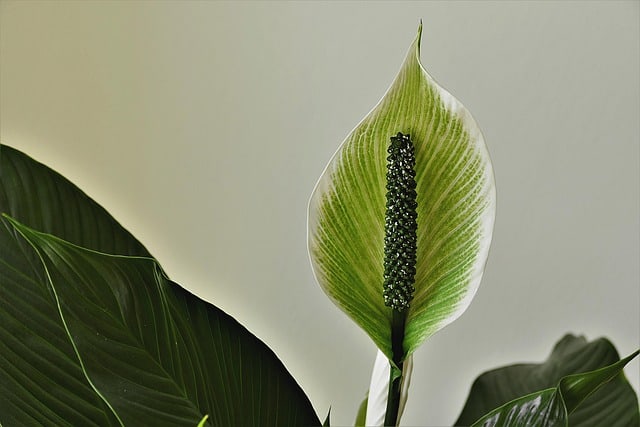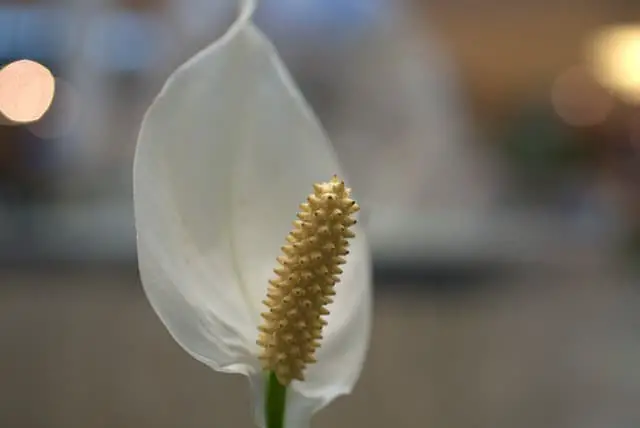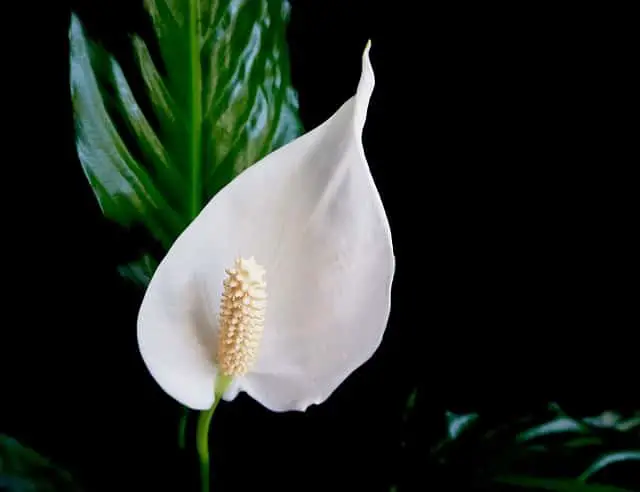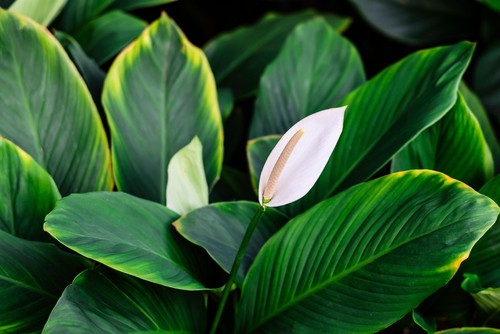Peace lilies are popular houseplants known for their lush green foliage and beautiful white flowers. However, it’s not uncommon for peace lily leaves to develop black spots, which can be a cause for concern for plant owners.
Black spots on peace lily leaves can be an indication of various issues, from pests and diseases to improper care.
Understanding peace lily care is essential to prevent black spots from appearing on the leaves. Peace lilies prefer bright, indirect light and moist but not waterlogged soil. Overwatering, underwatering, and exposure to direct sunlight can all cause black spots to appear on the leaves.
Additionally, peace lilies are susceptible to pests and diseases, such as spider mites, mealybugs, and leaf spot diseases, which can lead to black spots on the leaves.
Key Takeaways
- Black spots on peace lily leaves can indicate various issues, including pests, diseases, and improper care.
- Proper peace lily care involves providing bright, indirect light and moist but not waterlogged soil.
- Preventing and treating black spots on peace lily leaves involves addressing the underlying cause, such as pests, diseases, or improper care.
Similar posts:
Understanding Peace Lily

1. Peace Lily as a Houseplant
Peace lily (Spathiphyllum) is a popular houseplant known for its attractive foliage and stunning flowers. It is native to the tropical rainforests of Central and South America, where it grows as an understory plant. Peace lilies are easy to care for and can thrive in low light conditions, making them an ideal choice for indoor gardening.
The plant features glossy, dark green leaves that grow in an upright fashion. The leaves are lance-shaped and can grow up to 12 inches long. The flowers of the peace lily are white and have a unique shape that resembles a calla lily. The flowers can last for several weeks, making them a popular choice for cut flowers.
2. Origin and Habitat
Peace lilies are native to the rainforests of Central and South America, including the Amazon basin. They are found growing on the forest floor in areas with low light and high humidity. The plant is adapted to growing in shaded areas and can tolerate low light conditions.
In their natural habitat, peace lilies grow in well-draining soil that is rich in organic matter. The soil is usually moist, but not waterlogged. The plant can also grow in soil that is slightly acidic to neutral.
The peace lily has become a popular houseplant because of its adaptability to indoor growing conditions. It is often used as a decorative plant in homes, offices, and other indoor spaces. The plant is also known for its air-purifying qualities, making it a popular choice for improving indoor air quality.
In conclusion, peace lilies are a popular houseplant known for their attractive foliage and stunning flowers. They are native to the tropical rainforests of Central and South America and are adapted to growing in shaded areas with high humidity.
The plant is easy to care for and can thrive in low light conditions, making it an ideal choice for indoor gardening.
3 Common Problems in Peace Lily
Peace lilies are popular houseplants known for their attractive foliage and beautiful white flowers. However, like any other plant, peace lilies can develop problems that can affect their growth and overall health. Here are some of the most common problems that peace lilies encounter:

1. Black Spots on Leaves
One of the most common problems that peace lilies face is the appearance of black spots on their leaves. This can be caused by several factors, including overwatering, poor drainage, and fungal infections.
Overwatering can lead to root rot, which can cause the leaves to turn black and eventually die. Poor drainage can also cause water to accumulate in the soil, leading to root rot and black spots on the leaves.
Fungal infections, such as Cercospora leaf spot, can also cause black spots on peace lily leaves. These infections are usually caused by high humidity and poor air circulation.
To prevent black spots on the leaves, make sure to water your peace lily sparingly and provide good drainage. Also, make sure to keep the air around the plant circulating by placing it near a fan.
2. Wilting and Yellowing
Wilting and yellowing of peace lily leaves are also common problems that can be caused by several factors. One of the most common causes is overwatering, which can lead to root rot and poor growth. Another cause of wilting and yellowing is exposure to direct sunlight, which can cause the leaves to burn and turn yellow.
To prevent wilting and yellowing, make sure to water your peace lily sparingly and avoid exposing it to direct sunlight. Also, make sure to provide good drainage and keep the soil moist but not waterlogged.
3. Discoloration and Stunted Growth
Discoloration and stunted growth are also common problems that peace lilies encounter. These problems can be caused by several factors, including poor soil quality, lack of nutrients, and exposure to extreme temperatures.
To prevent discoloration and stunted growth, make sure to use high-quality soil and provide your peace lily with adequate nutrients. Also, make sure to avoid exposing it to extreme temperatures, such as cold drafts or hot, dry air.
In conclusion, peace lilies are beautiful and easy-to-care-for houseplants, but they can encounter problems that can affect their growth and health. By understanding the common problems that peace lilies face and taking steps to prevent them, you can ensure that your peace lily remains healthy and vibrant for years to come.
Black Spots on Peace Lily Leaves – 6 Causes of Black Spots

Black spots on peace lily leaves can be caused by various factors, ranging from improper watering to pests and diseases. Understanding the causes of black spots is crucial in preventing and treating the condition. In this section, we will discuss the most common causes of black spots on peace lily leaves.
1. Overwatering
Overwatering is one of the most common causes of black spots on peace lily leaves. When the soil is consistently wet, it can lead to root rot, which can cause the leaves to turn black and eventually die.
It is important to ensure that the soil is moist but not waterlogged. One way to prevent overwatering is to check the soil moisture level regularly and water only when the top inch of soil is dry.
2. Underwatering
On the other hand, underwatering can also cause black spots on peace lily leaves. When the soil is too dry, the plant will start to wilt, and the leaves may turn black and crispy.
It is important to water the plant thoroughly and ensure that the water reaches the roots. One way to check if the plant needs water is to stick your finger into the soil. If it feels dry, it’s time to water the plant.
3. Water Quality
Water quality can also affect the health of peace lilies. Hard water or water that contains high levels of minerals can cause the leaves to turn black and yellow. It is important to use filtered or distilled water to prevent this issue.
4. Fertilizer Burn
Overfertilizing or using too much fertilizer can cause the leaves to turn black and crispy. Fertilizer burn can occur when the plant is exposed to too much fertilizer, causing the roots to burn. It is important to follow the recommended dosage and frequency of fertilization.
5. Location
The location of the peace lily can also affect its health. Direct sunlight can cause the leaves to turn black and brown due to sunburn. It is important to place the plant in a location with bright, indirect light.
6. Pests and Diseases

Pests and diseases can also cause black spots on peace lily leaves. Fungal infections and spider mites can cause the leaves to turn black and eventually die. It is important to inspect the plant regularly and treat any pests or diseases promptly.
In summary, black spots on peace lily leaves can be caused by various factors, including improper watering, water quality, fertilizer burn, location, and pests and diseases. It is important to identify the cause of the issue and take appropriate measures to prevent and treat the condition.
Pests and Diseases
Peace lilies are prone to several pests and diseases that can cause black spots on their leaves. Here are some of the most common culprits:
1. Fungal Infections
Fungal infections are a common cause of black spots on peace lily leaves. Cercospora, Rhizoctonia, and Phyllosticta are some of the most common fungi that cause leaf spot diseases in peace lilies.
These fungi thrive in warm and humid conditions, making peace lilies an ideal host. The best way to prevent fungal infections is to avoid overwatering and ensure good air circulation around the plant.
2. Pests Infestation
Mealybugs, aphids, spider mites, and thrips are common sap-sucking pests that can cause black spots on peace lily leaves. These pests feed on the plant’s sap, causing the leaves to turn yellow and develop black spots.
Regularly inspecting the plant and removing any infested leaves can help control the pest population. Additionally, using insecticidal soap or neem oil can help prevent further infestation.
3. Leaf Blight
Leaf blight is another common disease that can cause black spots on peace lily leaves. This disease is caused by a fungus that thrives in warm and humid conditions. The fungus can spread rapidly, causing the leaves to turn yellow and brown before developing black spots.
The best way to prevent leaf blight is to avoid overwatering and ensure good air circulation around the plant. Additionally, removing any infected leaves and using a fungicide can help control the disease.
In conclusion, black spots on peace lily leaves can be caused by a variety of pests and diseases, including fungal infections, pest infestation, and leaf blight. Regular inspection of the plants and proper care can help prevent and control these issues.
Peace Lily Care Guide
Peace lilies are popular houseplants due to their attractive foliage and easy care requirements. They are native to tropical regions and thrive in warm, humid environments. Here are some tips for caring for your peace lily:
1. Watering
Peace lilies prefer moist conditions but do not like to sit in water. Over-watering can lead to root rot and black spots on the leaves. Water your peace lily when the top inch of soil feels dry to the touch. Use distilled or rainwater if possible, as peace lilies are sensitive to chemicals in tap water.
2. Soil

Peace lilies prefer well-draining soil that retains moisture. Use a high-quality potting soil and ensure that the pot has drainage holes to prevent water from pooling at the bottom.
3. Light
Peace lilies prefer bright, indirect light but can tolerate low light conditions. Direct sunlight can scorch the leaves, so it is best to keep them out of direct sunlight.
4. Fertilizer
Peace lilies do not require frequent fertilizing, but you can feed them once a month during the growing season with a balanced, water-soluble fertilizer. Be careful not to over-fertilize, as this can lead to burnt foliage.
5. Humidity
Peace lilies thrive in high humidity environments. If your home is dry, consider using a humidifier or placing a tray of water near the plant to increase humidity levels.
6. Disease
Black spots on peace lily leaves can be caused by fungal diseases such as Cercospora, Phyllosticta, or Rhizoctonia. To prevent disease, avoid getting water on the leaves and ensure that the plant has good air circulation. If you notice black spots on the leaves, remove the affected leaves and treat the plant with a fungicide.
7. Temperature and Pot Size
Peace lilies prefer warm temperatures between 65-80°F (18-27°C) and can be grown in pots of various sizes. However, they prefer to be slightly root-bound and do not require frequent repotting.
By following these simple care guidelines, you can keep your peace lily healthy and free of black spots on the leaves.
Preventing and Treating Black Spots

Peace lilies are prone to developing black spots on their leaves, which can be caused by several factors, including root rot, fungal diseases, and pests. Here are some tips to help prevent and treat black spots on peace lily leaves:
Prevention
- Proper watering: Overwatering can lead to root rot and other fungal diseases. Ensure that the soil is moist but not waterlogged, and allow the top inch of soil to dry out before watering again.
- Humidity: Peace lilies thrive in high humidity, so consider using a humidifier or placing a tray of water near the plant.
- Lighting: Peace lilies prefer bright, indirect light, but too much direct sunlight can scorch their leaves. Avoid placing them in low light conditions.
- Soil mix: Use a well-draining soil mix that allows excess water to drain away from the roots.
- Potassium and magnesium: Ensure that the plant has enough potassium and magnesium, which are essential micronutrients for healthy growth.
- Fluoride: Avoid using water that contains high levels of fluoride, which can cause brown tips and black spots on peace lily leaves.
Treatment
- Fungicide: If the black spots are caused by a fungal disease, use a pathogen-specific fungicide to treat the plant. Follow the instructions carefully and avoid overusing the product.
- Repotting: If the peace lily is overwatered or has root rot, repotting it in fresh soil can help to save the plant. Remove any dead or damaged roots and trim off any blackened leaves before repotting.
- Withhold water: If the peace lily is overwatered, withhold water for a while to allow the soil to dry out. This can help to prevent further root rot and fungal diseases.
- Shower the plant: If the plant is infested with pests, showering it with water can help to remove them. Be sure to spray the undersides of the leaves as well.
- Homemade solutions: For minor pest infestations, homemade solutions such as neem oil or insecticidal soap can be effective.
- Insecticide: For more severe pest infestations, use a species-specific insecticide to treat the plant. Follow the instructions carefully and avoid overusing the product.
By following these tips, peace lily owners can prevent and treat black spots on their plants, ensuring that they remain healthy and vibrant.
Related Plants
Peace lilies belong to the Araceae family, which includes several other popular houseplants such as Anthurium and Philodendron. These plants share similar characteristics, including their tropical origins and their ability to grow in low-light conditions.
1. Anthurium
Anthuriums are also known as Flamingo flowers or Tail flowers. They are native to Central and South America and are prized for their bright, showy blooms that come in a variety of colors including red, pink, and white.
Like Peace lilies, Anthuriums prefer low to medium light and well-draining soil. They can be propagated through cuttings or by division.
One common issue that Anthuriums face is root rot, which can be caused by overwatering or poor drainage. To prevent this, it’s important to allow the soil to dry out slightly between waterings and to ensure that the pot has adequate drainage holes.
2. Philodendron

Philodendrons are a diverse group of plants that come in many shapes and sizes. They are native to tropical regions of the Americas and are known for their large, glossy leaves. Like Peace lilies, Philodendrons are relatively easy to care for and can thrive in low-light conditions.
One popular variety of Philodendron is the Heartleaf Philodendron, which is often used in hanging baskets or as a trailing plant. Another popular variety is the Split-leaf Philodendron, which has large, deeply lobed leaves that resemble a palm tree.
One common issue that Philodendrons face is spider mites, which can cause yellowing and curling of the leaves. To prevent this, it’s important to keep the leaves clean and to mist the plant regularly to increase humidity.
In summary, Anthuriums and Philodendrons are two related plants that share many characteristics with Peace lilies. By understanding the care requirements and common issues of these plants, you can become a more knowledgeable and confident plant parent.
Frequently Asked Questions
How do you fix black leaves on a peace lily?
Black leaves on a peace lily are typically caused by overwatering, underwatering, or exposure to direct sunlight. To fix black leaves on a peace lily, first identify the cause of the problem. If the soil is too wet, allow it to dry out before watering again.
If the soil is too dry, water the plant thoroughly. If the plant is exposed to direct sunlight, move it to a location with indirect sunlight. Prune any damaged leaves to promote new growth.
Peace lily leaves turning black at tips
If the tips of peace lily leaves are turning black, it may be due to exposure to cold temperatures or dry air. Peace lilies prefer warm, humid environments. To fix black tips on peace lily leaves, move the plant to a location with warmer temperatures and higher humidity levels.
Mist the leaves with water or place a humidifier nearby to increase humidity levels.
Peace lily leaves turning black and yellow
If peace lily leaves are turning black and yellow, it may be due to a fungal infection or root rot. To fix black and yellow leaves on a peace lily, first identify the cause of the problem. If the soil is too wet, allow it to dry out before watering again.
If the roots are damaged, repot the plant in fresh soil. Prune any damaged leaves to promote new growth.
Peace lily leaves turning black and crispy
If peace lily leaves are turning black and crispy, it may be due to exposure to direct sunlight or lack of water. Peace lilies prefer indirect sunlight and moist soil. To fix black and crispy leaves on a peace lily, move the plant to a location with indirect sunlight and water it thoroughly. Prune any damaged leaves to promote new growth.
Why does my peace lily have dark spots on leaves?
Dark spots on peace lily leaves are typically caused by fungal infections or pest infestations. To fix dark spots on peace lily leaves, first identify the cause of the problem. If the plant is infected with pests, treat it with an insecticide.
If the plant has a fungal infection, treat it with a fungicide. Prune any damaged leaves to promote new growth.
Should I cut black leaves off peace lily?
Yes, it is recommended to cut black leaves off a peace lily. Black leaves are typically a sign of damage or disease and can spread to other parts of the plant. Prune any damaged leaves to promote new growth and prevent the spread of disease.

Hey, I’m Lisa and I’ve been an avid gardener for over 30 years. I love writing, talking and living in the garden! Feel free to connect with me on my socials below


